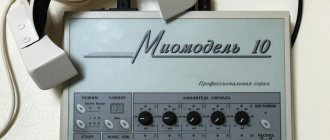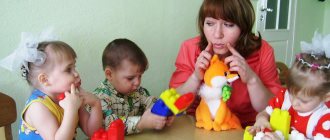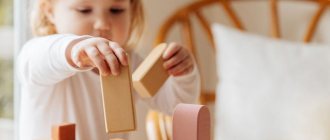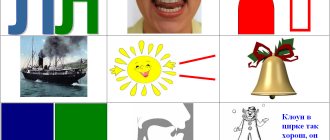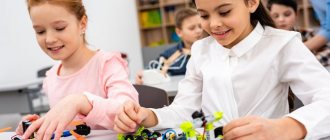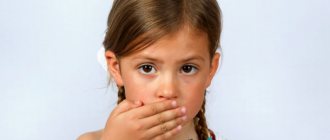Work programs of a speech therapist for children with special needs development
Chebotareva Tatyana, speech therapist
A frequently asked question among parents is: “What is OHP?”
OSD is a general underdevelopment of speech in a child with normal hearing and intact intelligence, but the formation of all components of speech is impaired: phonetics, vocabulary, grammar, semantics.
OHP is an indicator (not a disease) of how a child speaks.
Diagnosis up to 3 years: “ZRD” – delayed speech development.
Diagnosis from 3 years of age: “ONR (with a dysarthric component)”, “ONR level III as a consequence of MMD”, “ONR, level III speech development against the background of impaired innervation of the speech apparatus.”
In case of reduced intelligence in a child with mental retardation of levels I, II, III, ONR is secondary and in the diagnosis it sounds like “Systemic underdevelopment of speech in a child with intellectual disability.”
OHP is characterized by:
- Late appearance of speech;
- Severely limited vocabulary;
- Presence of agrammatisms;
- Problems of phonetic-phonemic development of speech.
Reasons for OHP:
- Pedagogical neglect;
- Bilingualism in the family;
- Impaired phonemic hearing due to decreased physical hearing;
- Absence of clear dyskinesias (sensations of movement of articulatory organs).
ONR is observed in speech disorders such as rhinolalia, alalia, dysarthria, and anarthria. OHP is always functional and has no organic origin.
OHP, level I - the most difficult.
Complete or almost complete absence of speech at an age when it is already formed in normally developing children. A child with level I speech development speaks babbling words, fragments of words, onomatopoeia, and uses gestures instead of words. There is no phrasal speech. The ability to reproduce the sound and syllabic structure of a word is not formed. Understanding may be impaired and limited by everyday situations. The tasks are difficult to complete. Reduced understanding of grammatical categories: the number of nouns and verbs (where poYut, where sings); gender of singular past tense verbs (upaL – upaLA); type of verbs (writes – wrote); spatial position of objects (on, in, under, above, from, because of).
Conclusion: children with level I of speech development receive speech therapy help from the age of 3 during a three-year stay in the speech therapy group of a kindergarten.
ONR, level II – speech capabilities are increasing.
Communication is carried out not only through gestures with babbling fragments of words, but also through constant, albeit distorted, words. The beginnings of common speech appear. The names of objects and actions appear in the active dictionary. A simple phrase of 2-3 words appears, and the volume of speech understanding increases. The grammatical categories of gender and number appear. An understanding of gender needs to be fostered through pictures, preferably using the example of animals and their young (this is how the child becomes familiar with diminutive suffixes). At this level there is still no agreement between nouns and adjectives. Speech understanding improves. The pronunciation of sounds and words is grossly impaired, sound analysis and synthesis are unavailable.
Conclusion: children with level II speech development enter the speech therapy group from the age of 4 for a period of study of 3 years.
OHP, level III – everyday speech is more or less developed, but there is inaccurate knowledge and use of many everyday words.
The active vocabulary is dominated by nouns and verbs. There are attempts to form complex sentences. Children begin to use all parts of speech, change them according to persons, numbers, and cases. Errors in case endings, confusion of verb forms, errors in agreement and control. Word formation methods are not used; there is no prefix formation of verbs. Words of different syllable structure and sound content appear. Sound pronunciation is impaired, which creates difficulties in mastering sound analysis and synthesis. Understanding of everyday speech is good, but sometimes ignorance and confusion of the meaning of words that sound similar appear.
Conclusion: children with level III speech development enter the speech therapy group from the age of 5 for a period of study of 2 years.
Individual development program for a child with special needs development
Natalia Loboda
Individual development program for a child with special needs development
development program for a child with level 1 ODD , complicated by mental retardation.
1. Explanatory note.
1.1. The goal of this program is aimed at correcting the speech development of a child with level 1 ODD (with sensory-motor alalia, complicated by SPD, in the conditions of a speech center.
1.2. To achieve this goal, the following tasks are highlighted:
-development of an impressive and expressive vocabulary of nouns, adjectives, verbs;
-formation of the grammatical structure of speech;
-development of the phonemic side of speech;
— development of mental processes;
-development of motor skills;
-cognitive development .
1.3. The program is built on the principle of unity of correction and development ; the principle of complexity of methods of influence; the principle of active involvement of parents and their immediate environment; the principle of the activity approach.
1.4. A child developmental problems experiences great difficulty in classifying by shape, color, and size. He experiences exhaustion of attention, delayed memorization, excitability, negativism, and hyperactivity. All speech operations and all stages of speech production are grossly impaired. Pronounces words of lightweight construction, onomatopoeia of animals. Therefore, the leading direction in correction is the development of mental processes, cognitive activity, motor skills with speech accompaniment.
1.4. Planned results at the end of correctional training.
The child must be able to hold a pencil, trace an image of an object with the help of an adult, and work with a construction set (based on the Lego principle)
.
Must learn to understand sensory standards (big-small, blue-red, round-non-round)
. Under favorable circumstances, the student should learn to follow one-step instructions, have a larger vocabulary, and use two-word phrases.
Section II (content)
2. 1. Development of impressive vocabulary and expressive speech
Contents of work Methods and means
Accumulating vocabulary Exercise “Show”
, ball game, exercise
“Order”
, reading art. liters.
Activation of words in speech Ex. "Who is this?"
,
"What is he doing?"
,
"Which?"
Formation of grammatical structure of speech
Contents of work Methods and means
Teaching the formation of unit forms. and many more numbers of nouns, their coordination with verbs and adjectives I. “One-many”
,
“Find a house”
, Lotto
Development of the phonetic side
Contents of work Methods and means
Teach imitation of speech sounds Exercise “Repeat”
Develop phonemes . perception Exercise "Attentive ears"
Development of mental functions
Contents of work Methods and means
Formation of attention to non-speech sounds I. “Where is it thundering?”
,
“What does it sound like?”
,
“Stomp-clap”
Development of motor skills
Contents of work Methods and means
Development of body motor skills Active poetic games
Development of fine motor skills: Exercise with massage objects, drawing, playing with construction sets.
Cognitive development
Contents of work Methods and means
Formation of sensory standards Games with cubes, balls, etc.
program implementation period is from February to May 2014.
2.2. Working with family.
The speech therapist conducts weekly conversations about the results of correctional work in the classroom,
monthly introduce parents to the lexical material used in class.
Provide information support to the family in the form of literature and Internet resources.
Section III (organizational)
3.1. Logistics support.
In speech therapy work, pencils and paper, massage objects, balls, construction sets, object pictures, and toys are used.
3.2. Methodological support.
Plan-program of correctional and developmental work in the junior group N. V. Nishcheva,
didactic material “Play”
, notebook
“Let's study together”
.
3.3 Lesson schedule.
Classes are held in the speech therapy room 3 times a week according to the schedule:
Tuesday from 10:20 to 10:35
Thursday from 16:30 to 17:45
Friday from 10:10 to 10:25
MAGAZINE Preschooler.RF
Rusova Galina Vladimirovna teacher-speech therapist MBDOU MO Krasnodar “Kindergarten of a combined type No. 175 Krasnodar city(for the 1st period: September, October, November) Contents Development of the dictionary
Expand, clarify and activate the vocabulary based on generalizing knowledge within the framework of the lexical topics being studied; Replenish the vocabulary of nouns. with diminutive and augmentative suffixes; adj. with diminutives suff., relative and possessive. adj. prefixed verbs; Introduce into speech complex words, unchangeable words, antonym words, synonymous words; Continue to develop the skill of using simple and complex prepositions (because of, from under); Enrich speech with numerals, pronouns, adverbs, participles Improve the grammatical structure of speech
Develop the ability to form nouns. units and many more numbers in Im. case; Strengthen the ability to form nouns. units and many more h. In indirect cases; Improve the ability to form nouns. and adj. with mind suf.; Strengthen the skill of agreement adj. and numbers. with noun in gender, number, case; Improve the skill of distributing simple sentences by homogeneous members; Improve the skill of composing compound and complex sentences; Strengthen the skill of analyzing proposals. Development of the prosodic side of speech Continue work on the development of speech breathing; Develop the ability to change the strength of the voice (quietly, loudly, whisper); Develop the timbre coloring of the voice; Continue to work on clear diction. Correction of the pronunciation side of speech Continue work on developing the movements of the speech apparatus; Continue automating the correct pronunciation of sounds………..in play and free speech activities; Working on the syllable structure of a word
Strengthen the skills of pronunciation of three-syllable words with a combination of consonants (leaf fall); Strengthen the ability to correctly pronounce monosyllabic words with a combination of consonants (sheaf, leaf); To develop the ability to correctly pronounce two-syllable words with two consonant clusters (bed, abdomen); Improve the ability to perform syllabic analysis and synthesis of words from one, 2, 3 syllables, select words with a given number of syllables. Development of f/perception, sound analysis and synthesis skills. Strengthens knowledge of the characteristics of vowels and consonants, the ability to select words for a given sound; To consolidate ideas about hardness-softness, deafness-voice; Improve the ability to isolate sound from the background of a word, perform sound analysis and synthesis of words like: poppy, wasps, forest; To develop the ability to perform sound analysis and synthesis of words like: puddle, fang, beaver; Form ideas about the sound “th”. Literacy training
Improve the ability to “type” letters, syllables, words with completed letters; Introduce the letters Y, E, E, Yu, I, teach to read syllables, words, sentences with new letters; Strengthen the ability to recognize letters with missing elements or “noisy” letters; distinguish between correctly and incorrectly printed letters; Reinforce your knowledge of known spelling rules. Development of coherent speech and verbal communication
Improve the skills of conducting dialogue, the ability to ask questions, answer them fully and briefly; Strengthen the ability to compose descriptive stories and descriptive riddles on lexical topics according to a given plan; Improve the skill of retelling fairy tales and short texts according to a given plan; Teach retelling with changes in the time of action and the face of the narrator; Improve the skill of composing stories based on a series of paintings according to a given plan.
| Next > |

